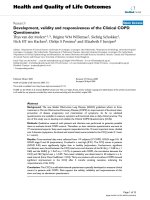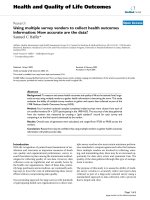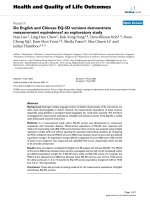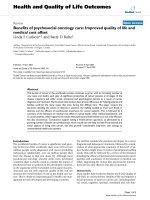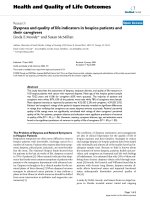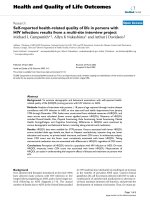Health and Quality of Life Outcomes BioMed Central Review Open Access Quality of life and potx
Bạn đang xem bản rút gọn của tài liệu. Xem và tải ngay bản đầy đủ của tài liệu tại đây (216.66 KB, 6 trang )
BioMed Central
Page 1 of 6
(page number not for citation purposes)
Health and Quality of Life Outcomes
Open Access
Review
Quality of life and psychosocial adjustment in gynecologic cancer
survivors
Timothy Pearman*
Address: Tulane University Medical Center, 1415 Tulane Avenue, Box HC-62 New Orleans, LA 70112, U.S.A
Email: Timothy Pearman* -
* Corresponding author
Abstract
Gynecologic malignancies occur in approximately 1 in 20 women in the United States. Until
recently, clinical management of these cancers has focused almost exclusively on prolonging the
survival of patients. A recent literature search using MEDLINE revealed relatively few research
studies that reported data on quality of life (QOL) in a gynecologic cancer population. Reports in
the literature have been conflicting, with some studies finding deterioration in QOL and some
finding stability or improvement in QOL over time. Until recently, the impact of various treatments
(surgery, radiation, chemotherapy) on QOL in this population was unknown. Recently, the QOL
of women with gynecologic cancer has been compared to that of women with other types of
cancer. Also, risk factors for poor adjustment in gynecologic cancer are beginning to be
investigated. This presentation will attempt to 1) summarize the relevant literature on QOL in a
gynecologic cancer population, 2) compare QOL in this population to other types of cancer, 3)
examine risk factors for poor adjustment and 4) describe the limitations of the literature and future
research directions.
Overall, it appears that QOL is most negatively affected from time of diagnosis through completion
of treatment. Following treatment, QOL appears to improve over the course of 6–12 months, but
then appears to remain stable from that time through two years post-treatment. Compared to
breast cancer patients, it appears that gynecologic cancer patients experience poorer QOL on
several domains during active treatment, but that after completion of treatment, overall QOL is
similar between groups. Risk factors for maladjustment include treatment with radiotherapy or
multi-modality treatment, increased length of treatment, younger age, and coping using a
disengaged style. Other risk factors include lower education, poor social support and lower levels
of religious belief. The significance of these findings and future research directions will be discussed.
Review of Literature
Until recently, treatment for gynecologic malignancies has
focused almost exclusively on prolongation of life, and
few research studies have adequately addressed issues
related to quality of life [1]. Quality of life (QOL) typically
involves the assessment of several dimensions: physical
well-being, emotional well-being, social well-being, and
functional well-being. As recently as 1993, Andersen pub-
lished an article acknowledging a grave lack of research on
quality of life and challenging "institutions and study
groups to support quality of life research for women with
gynecologic cancer" [2]. To date, few studies have utilized
QOL as a primary endpoint.
Published: 20 August 2003
Health and Quality of Life Outcomes 2003, 1:33
Received: 16 July 2003
Accepted: 20 August 2003
This article is available from: />© 2003 Pearman; licensee BioMed Central Ltd. This is an Open Access article: verbatim copying and redistribution of this article are permitted in all media
for any purpose, provided this notice is preserved along with the article's original URL.
Health and Quality of Life Outcomes 2003, 1 />Page 2 of 6
(page number not for citation purposes)
Numerous challenges exist in treating gynecologic malig-
nancies. Often, there are few, if any, symptoms until the
tumor is in an advanced stage. Further, these symptoms
are often non-specific and may consist of things like
abdominal distention, vaginal bleeding, abdominal or
low back pain, often leading treating professionals to mis-
interpret early signs or defer further work-up. Treatment
for gynecologic malignancies is often quite morbid and
may involve multiple modalities (surgery, radiation and
chemotherapy). Changes in bowel, bladder, hormonal,
sexual and reproductive function are common. In addi-
tion, palliation is often difficult in the terminal stage, and
death from a slow, obstructive, intra-abdominal process is
not unusual.
Women frequently must adjust to physical changes after
treatment including loss of ovarian function, hot flashes,
vaginal dryness, hair and skin changes, and mood
changes. Surgical scarring may be another hurdle to
adjustment, as are the need for urostomy or colostomy.
Sexual functioning may be impaired, and difficulties with
desire and sexual response are common. Dyspareunia is
also frequently experienced. Infertility is an issue for many
young women diagnosed with gynecologic cancer, and
concerns may include adoption, egg donation, and
surrogacy.
The goals of the present article are to summarize what is
known about QOL in women treated for gynecologic
malignancies, compare QOL in women with gynecologic
versus other malignancies, attempt to draw tentative con-
clusions about variables affecting quality of life and risk
factors for maladjustment, and suggest directions for
future research.
Quality of life in women with gynecologic cancer
Bodurka-Bevers and colleagues [3] assessed the prevalence
of depression and anxiety in 246 women diagnosed with
ovarian cancer. These patients were at all stages of disease,
and also were in various phases of active treatment or sur-
veillance. Results suggested that 21% met criteria for
depression and 29% scored above the 75
th
percentile for
anxiety. Performance status was related to depression and
anxiety. The authors conclude that the prevalence of
depression and anxiety may be higher than expected in an
ovarian cancer population, and this clearly highlights the
need for further assessment of QOL in this group of
patients.
Miller, Pittman and Strong [4] also highlighted the need
for assessment of quality of life and emotional function-
ing. These researchers administered questionnaires to 95
patients with gynecologic cancer at least 6 months after
completion of treatment. The questionnaires asked
patients to retrospectively rate any emotional symptoms
experienced during active treatment. 57% of patients
reported needing help dealing with emotional problems.
A majority of patients wanted their physicians to ask ques-
tions dealing with spirituality, death and dying, and emo-
tional problems.
Capelli et al. [5] studied 115 women between the ages of
21 and 83 years who were referred to a university hospital
for ovarian, endometrial and cervical cancer. Women
completed the SF-36 questionnaire, a widely used and
well-validated QOL instrument. The authors then com-
pared these scores with age-specific expected mean values
in published data from a healthy population of women.
Results of this research suggested that women with pri-
mary (as opposed to recurrent) gynecologic cancer had
QOL scores that were similar overall to healthy women.
However, patients with recurrent disease scored an aver-
age of 10 points lower on each scale of the SF-36. Also
notable was the fact that women with primary gyneco-
logic cancer scored lower than healthy women on scales
measuring emotional and physical role functioning.
Patients undergoing palliative chemotherapy treatment
had the lowest scores overall, as would be expected.
The authors also used linear regression to adjust for age
and primary vs. progressive/recurrent disease status.
Results of this analysis showed that the poorest QOL
scores were reported by the youngest women with cervical
cancer. This was especially true in young women with
recurrent disease. This was in opposition to women with
ovarian and endometrial cancer where age was negatively
correlated with QOL.
Wenzel et al. [6] studied the QOL of long-term (over 5
years) survivors of ovarian cancer. 49 women were
assessed and the results indicated that this disease-free
sample enjoyed a good QOL compared to other cancer
survivors and non-cancer cohorts. However, approxi-
mately 20% of survivors reported significant long-term
treatment related side effects, including abdominal, gyne-
cologic and neurologic toxicity. Furthermore, greater than
half of the women surveyed indicated that they would
have attended a support group if one were available to
them at the time of diagnosis and treatment.
Quality of life in women with gynecologic cancer
compared to other populations
Greimel and colleagues [7] prospectively assessed 248
women with gynecologic or breast cancer. QOL data
(EORTC-30, Spitzer QL-I) was collected at six points from
pre- to post-treatment. The first assessment of QOL was
conducted at one day prior to initiation of treatment. The
final assessment was performed at one year post-treat-
ment. The mean age of patients was 55 years. Of the
Health and Quality of Life Outcomes 2003, 1 />Page 3 of 6
(page number not for citation purposes)
subjects, 26.2% were diagnosed with breast cancer, 31.9%
with cervical cancer, 25.8% with ovarian cancer, and
16.1% with endometrial cancer.
At pre-treatment, there were no statistically significant dif-
ferences between breast cancer and gynecologic cancer
patients on any QOL domain. During active treatment,
breast cancer patients had significantly higher QOL
scores, particularly in the areas of physical functioning
and role functioning. At completion of treatment, breast
cancer patients scored significantly lower on emotional
functioning compared to patients with ovarian cancer. At
six-month and one year post-treatment follow-up visits,
there were no significant differences between breast can-
cer and gynecologic cancer patients on any of the QOL
domains assessed.
Overall, the researchers conclude that during active treat-
ment patients with gynecologic cancer are significantly
more physically impaired compared to breast cancer
patients. However, QOL is comparable between groups at
one-year follow-up, suggesting that gynecologic cancer
survivors experience significant improvement in QOL fol-
lowing treatment. Predictors of long-term QOL included
pre-treatment performance status and severity of surgery.
Not predictive was family support, number of treatments,
age, stage or site of disease.
Miller, Pittman, Case & McQuellon [8] compared QOL in
disease-free gynecologic cancer patients (N = 85) to that of
42 unmatched healthy women seen for standard gyneco-
logic screening exams. Their data showed no overall dif-
ference in FACT-G scores between gynecologic cancer
patients and normal women. In fact, cancer survivors
scored slightly higher on the emotional well-being sub-
scale. Within the cancer survivors, QOL appears poorest in
women diagnosed with ovarian cancer.
Patients who had treatment over a longer period of time
reported decreased functional well being and total FACT-
G scores. It should be noted that these patients tended to
have an ovarian cancer diagnosis and most had been
treated with surgery and approximately 6 months of com-
bination chemotherapy. Patients treated with surgery only
had better overall QOL, probably due to short treatment
time and less advanced disease. The authors note that
prior research has shown that acute treatment effects are
resolved after 6 months, and there is only little change
expected thereafter.
Also related to lower QOL scores was lower education
level. The authors propose that lower levels of education
may be predictive of a less supportive social environment,
limited knowledge of health issues and poor general
health. Lack of help at home was also predictive of poor
QOL.
Predictors of quality of life in women with gynecologic
cancer
Eisemann & Lalos [9] assessed well-being in women with
endometrial and cervical cancer at pre-treatment and also
at 6 month and 1 year post-treatment. Subjects completed
a clinical interview and also brief, non-standardized ques-
tionnaires. Results showed that cervical cancer patients
reported significantly more symptoms at all time points.
Furthermore, well-being before treatment was signifi-
cantly predictive of post-treatment well-being.
Chan and colleagues [10] performed a prospective, longi-
tudinal study of 74 newly diagnosed gynecologic cancer
patients. QOL was measured at 4 points from pre-treat-
ment to 18 months post-treatment. A structured interview
was used to measure self-esteem, outlook on life, self-role
and femininity. It should be noted that this study only
included individuals who had no recurrence of their dis-
ease, so this may not be indicative of all patients diag-
nosed with gynecologic malignancies. Also notable is the
fact that all psychosocial variables were assessed at pre-
treatment primarily by clinical interview (as opposed to
more standardized assessment tools).
The study found that self-esteem and depression
remained constant over time. The incidence of depression
in this sample was twice that seen in a healthy population.
Subjects reported no change in relationship with spouse
and sexual activity (though this may have been under-
reported due to the fact that this variable was assessed by
clinical interview). The authors found three high-risk
groups for maladjustment; those with low religious belief,
those who had received surgical treatment, and those with
low educational level.
Lutgendorf and colleagues [11] assessed 98 women with
early stage or regionally advanced gynecologic cancer.
Prospective assessments were done measuring QOL
(FACT-G), coping style (COPE) and mood (POMS) at pre-
treatment and one year post-diagnosis. Sleep disturbance
was common throughout the study, and occurred in
approximately 40% of the sample. Lack of energy and sex-
ual satisfaction were the other two most common
complaints.
Surprisingly, medical factors such as disease extent and
treatment intensity did not significantly predict physical
well being at one year. However, coping strategies contrib-
uted significantly to the variance of physical well being,
even when medical factors were controlled. Over the
course of the first year following diagnosis, emotional and
functional well being improved significantly for both
Health and Quality of Life Outcomes 2003, 1 />Page 4 of 6
(page number not for citation purposes)
early stage and advanced patients. The authors note that
this improvement occurred even in the absence of signifi-
cant increases in physical well being, suggesting possible
adaptation to residual physical limitations. Decreases in
anxiety, depression and confusion were seen in both
groups, but regionally advanced patients had poorer QOL
and mood compared to early stage patients.
Interestingly, coping strategies appeared to be very predic-
tive of QOL at one year post-treatment. Specifically, posi-
tive reframing was associated with increases in functional
and physical well being. Greater disengagement (avoiding
problems, giving up attempts to cope) was associated with
poorer relationship with physician, poorer functional and
physical well being, and greater mood distress.
Another study by Chan and colleagues [12] assessed 144
women with newly diagnosed gynecologic cancer. These
subjects were assessed at pre-treatment, immediately post-
treatment, 6 month, 12 month and 24 month post-treat-
ment. They assessed the impact of age, symptoms, disease
parameters, and treatment type on QOL using the
EORTC-30. In this study as well, women with recurrent
disease were dropped from final analysis, so this likely
represents a sample of the most medically healthy
patients. This is important, as this study may not accu-
rately represent the QOL of all newly diagnosed women,
but may represent the QOL of newly diagnosed women
with the most favorable prognosis.
In contrast to their earlier study, the results suggested that
patients treated with surgery alone reported the best QOL
(compared to those treated with multi-modality treat-
ment). Younger patients reported poorer physical health
compared to older patients. Site and stage of disease had
no significant effect on QOL after treatment, and QOL
remained stable between 6–24 months following treat-
ment. Furthermore, overall QOL appeared to improve
after treatment, and this improvement was seen in global
health status, functional scales and symptom report
scales. There was a strong correlation between pre-treat-
ment QOL and that at 24 months post-treatment.
In another compelling study, Lutgendorf and colleagues
[13] assessed 48 women on QOL (FACT-G), mood
(POMS) and coping style (COPE). 24 women had
received one year of extensive chemotherapy, and 24
women had received no chemotherapy. QOL was meas-
ured at one year post-diagnosis.
Overall, extensively treated women reported substantial,
lasting decrements in physical, functional and emotional
well being. There were no differences between groups in
depressed or anxious mood. Avoidant coping again
seemed to predict poorer QOL, specifically in domains of
physical and emotional well being. Social well being
appeared unimpaired in both groups. Surprisingly, social
support was not associated with any of the outcome vari-
ables, and the authors suggest that perhaps social support
is not as important in maintaining QOL post-treatment as
it is during pre- and active treatment.
Conclusion
Gynecologic malignancies pose special risks for quality of
life. Despite the fact that gynecologic malignancies occur
in approximately 1 in 20 women in the United States,
QOL has not been widely researched, with the bulk of
research devoted to prolongation of life. Reports in the lit-
erature have been conflicting, with some finding deterio-
ration in QOL and some finding stability or improvement
over time. Little has been known about the impact of var-
ious treatments, diagnoses, stages of illness, and other risk
factors on QOL in these patients.
Given the challenges and changes that women must face
after a diagnosis of gynecologic cancer, QOL is an espe-
cially pertinent issue on which to focus. Before concluding
anything regarding QOL, however, several caveats are
important to note. First, it is important to utilize a well-
validated measure of QOL in order to compare QOL in
patients with gynecologic malignancies to any other
group of patients or healthy subjects. The studies reviewed
in the current paper have generally done so, with the
exception of three [6,9,10].
Second, due to the relatively small number of gynecologic
cancer patients seen at any one cancer center, most of the
research studies above have grouped gynecologic cancer
patients into one group, as opposed to separating out by
diagnosis. Because of this, any interpretation of the
impact of diagnosis on QOL must be tentative. Related to
this is the fact that type of treatment may be reflective of
stage of disease (i.e. patients with advanced disease will be
more likely to have multi-modality treatment, while
patients with early stage disease may have surgery alone).
As such, any interpretation of the impact of treatment type
on QOL must also be done cautiously and in the context
of disease stage.
Finally, recommendations are difficult to make based on
the research. There have been no prospective studies in
which gynecologic cancer patients have been randomly
assigned to any psychological or psychiatric treatment
before, during or after treatment. The author of this review
is currently planning such a study to investigate how a
structured, psychological support group will impact levels
of a growth factor (VEGF) which has been linked to cancer
progression in women with ovarian cancer.
Health and Quality of Life Outcomes 2003, 1 />Page 5 of 6
(page number not for citation purposes)
Despite the limitations of the current research, we can
draw some tentative conclusions regarding QOL in this
population. In sum, there appears to be a higher than
expected incidence of depression and anxiety in patients
undergoing treatment for gynecologic malignancies. This
is likely related to the high treatment toxicity and often
poor prognosis of many of these illnesses. It appears that
QOL is most negatively affected from the time of diagno-
sis through the completion of treatment. It also appears
that QOL is more substantially impaired during treatment
of gynecologic malignancies than during treatment of
other cancers. QOL typically improves after treatment for
6–12 months, then stabilizes. 1–2 years after treatment,
disease free patients report QOL that is generally equiva-
lent to other cancer survivors and healthy women.
Further, emotional and functional well-being increase
over the first year following treatment, even in the absence
Table 1: Quality of life in gynecologic cancer research studies
Authors Date QOL assessment Other assessments Major findings
Bodurka – Bevers et al. 2000 SF-36 CES-D, STAI -higher than expected prevalence of depression,
anxiety
Miller et al 2003 FACT-G self-report questionnaires 57% of patients reported needing help with needing
help with
Capelli et al 2002 SF-36 None Women with primary GYN CA had similar QOL to
healthy women
-Women with recurrent disease had significantly
poorer QOL compared to healthy women
Wenzel et al. 2002 telephone interview physical exam -long term survivors of ovarian CA report good QOL
compared to other cancer cohorts and healthy
individuals
-20% of individuals had significant long term
treatment-related side effects
Greimel et al. 2002 EORTC, QL-I KPS -GYN CA pts have poorer QOL compared to breast
CA pts during treatment
-Both groups have comparable QOL at one year
follow-up
-predictors of QOL included pre-tx KPS, severity of
surgery
Miller et al. 2002 FACT-G None no differences in QOL between disease-free GYN CA
pts and healthy women
-poorest QOL in pts with ovarian CA, longer
treatment
-risk factors for poor QOL included lack of education,
lack of help at home
Eisemann et al 1999 clinical interview non-standardized
questionnaires
pts with cervical CA have more physical symptoms
than pts with endometrial CA-pre-tx well-being
predicted post-tx well-being
Chan et al. 2001 clinical interview HAMAS, interview -incidence of depression in disease-free sample twice
that of normal population
-risk factors for poor QOL included lack of education,
low religious belief, surgical treatment
Lutgendorf et al 2002 FACT-G COPE, POMS -sleep disturbance, anergia sexual problems most
common problems
-coping style predicted QOL (even when medical
variables controlled)
-disease extent and treatment intensity did NOT
predict physical well-being
-QOL improved over 1 year period, even in the
absence of physical improvement
Chan et al. 2002 EORTC-30 None site and stage of disease had no impact on QOL
-younger pts reported poorer physical health
-QOL improved after treatment ended
-strong correlation between pre- and post-tx QOL
Lutgendorf et al. 2000 FACT-G COPE, POMS -extensive treatment led to poor QOL (physical,
functional, and emotional)
-avoidant coping predicted poor QOL
Publish with BioMed Central and every
scientist can read your work free of charge
"BioMed Central will be the most significant development for
disseminating the results of biomedical research in our lifetime."
Sir Paul Nurse, Cancer Research UK
Your research papers will be:
available free of charge to the entire biomedical community
peer reviewed and published immediately upon acceptance
cited in PubMed and archived on PubMed Central
yours — you keep the copyright
Submit your manuscript here:
/>BioMedcentral
Health and Quality of Life Outcomes 2003, 1 />Page 6 of 6
(page number not for citation purposes)
of corresponding increases in physical well-being, sug-
gesting adaptation to residual physical limitations.
Despite these positive results, a significant minority of
patients continue to report lasting emotional problems
and treatment related toxicities.
Risk factors for maladjustment include treatment with
radiotherapy or multi-modality treatment, increased
length of treatment, younger age, and coping using a dis-
engaged style. Lower levels of education and spiritual/reli-
gious belief, as well as lack of help at home, are also risk
factors for poor QOL. Surprisingly, site and stage of dis-
ease have not reliably been correlated with QOL.
Future research should include large, multicenter studies,
which would allow comparative analysis of QOL by diag-
nosis. Also, studies measuring the impact of various
chemotherapeutic agents on QOL should be undertaken,
as there appear to be long-lasting toxicities from many of
the chemotherapeutic regimens, which are only begin-
ning to be understood. Due to the difficulty in palliating
terminal illness, any studies focusing on improvement of
QOL in end-stage disease patients would be welcome and
clinically relevant.
Finally, prospective studies of the impact of psychological
treatments on QOL and prognostic factors should be
undertaken. Future studies will hopefully assist women in
coping with the challenges and rigors of treatment and
post-treatment toxicities. Ideally, these studies would
determine risk factors not only for psychological morbid-
ity, but also medical mortality and morbidity, and
attempt to modify psychosocial variables to improve sur-
vival time and quality of life.
References
1. Pignata S, Ballatori E, Favalli G and Scambia G: Quality of life:
gynaecological cancers. Ann Oncol 2001, 12(Suppl 3):S37-42.
2. Andersen BL: Predicting sexual and psychologic morbidity and
improving the quality of life for women with gynecologic
cancer. Cancer 1993, 71(Suppl 4):1678-1690.
3. Bodurka-Bevers D, Basen-Enquist K, Carmack CL, Fitzgerald MA,
Wolf JK, de Moor C and Gershenson DM: Depression, anxiety,
and quality of life in patients with epithelial ovarian cancer.
Gynecol Oncol 2000, 78:302-308.
4. Miller BE, Pittman B and Strong C: Gynecologic cancer patients'
psychosocial needs and their views on the physician's role in
meeting those needs. Int J Gynecol Cancer 2003, 13(2):111-119.
5. Capelli G, De Vincenzo RI, Addamo A, Bartolozzi F, Braggio N and
Scambia G: Which dimensions of health-related quality of life
are altered in patients attending the different gynecologic
oncology health care settings? Cancer 2002, 95(12):2500-2507.
6. Wenzel LB, Donnelly JP, Fowler JM, Habbal R, Taylor TH, Aziz N and
Cella D: Resilience, reflection, and residual stress in ovarian
cancer survivorship: a gynecologic oncology group study. Psy-
chooncology 2002, 11(2):142-153.
7. Greimel E, Thiel I, Peintinger F, Cegnar I and Pongratz E: Prospec-
tive assessment of quality of life of female cancer patients.
Gynecol Oncol 2002, 85:140-147.
8. Miller BE, Pittman B, Case D and McQuellon RP: Quality of life
after treatment for gynecologic malignancies: a pilot study in
an outpatient clinic. Gynecol Oncol 2002, 87:178-184.
9. Eisemann M and Lalos A: Psychosocial determinants of well-
being in gynecologic cancer patients. Cancer Nurs 1999,
22(4):303-306.
10. Chan YM, Ngan HYS, Yip PSF, Li BYG, Lau OWK and Tang GWK:
Psychosocial adjustment in gynecologic cancer survivors: A
longitudinal study on risk factors for maladjustment. Gynecol
Oncol 2001, 80:387-394.
11. Lutgendorf SK, Anderson B, Ullrich P, Johnsen EL, Buller RE, Sood
AK, Sorosky JI and Ritchie J: Quality of life and mood in women
with gynecologic cancer: A one year prospective study. Can-
cer 2002, 94(1):131-140.
12. Chan YM, Ngan HYS, Li BYG, Yip AMW, Ng TY, Lee PWH, Yip PSF
and Wong LC: A longitudinal study on quality of life after gyne-
cologic cancer treatment. Gynecol Oncol 2001, 83:10-19.
13. Lutgendorf SK, Anderson B, Rothrock N, Buller RE, Sood AK and
Sorosky JI: Quality of life and mood in women receiving exten-
sive chemotherapy for gynecologic cancer. Cancer 2000,
89(6):1402-1411.
14. Campos S: The impact of anemia and its treatment on
patients with gynecologic malignancies. Semin Oncol 2002, 29
Suppl 8:7-12.


